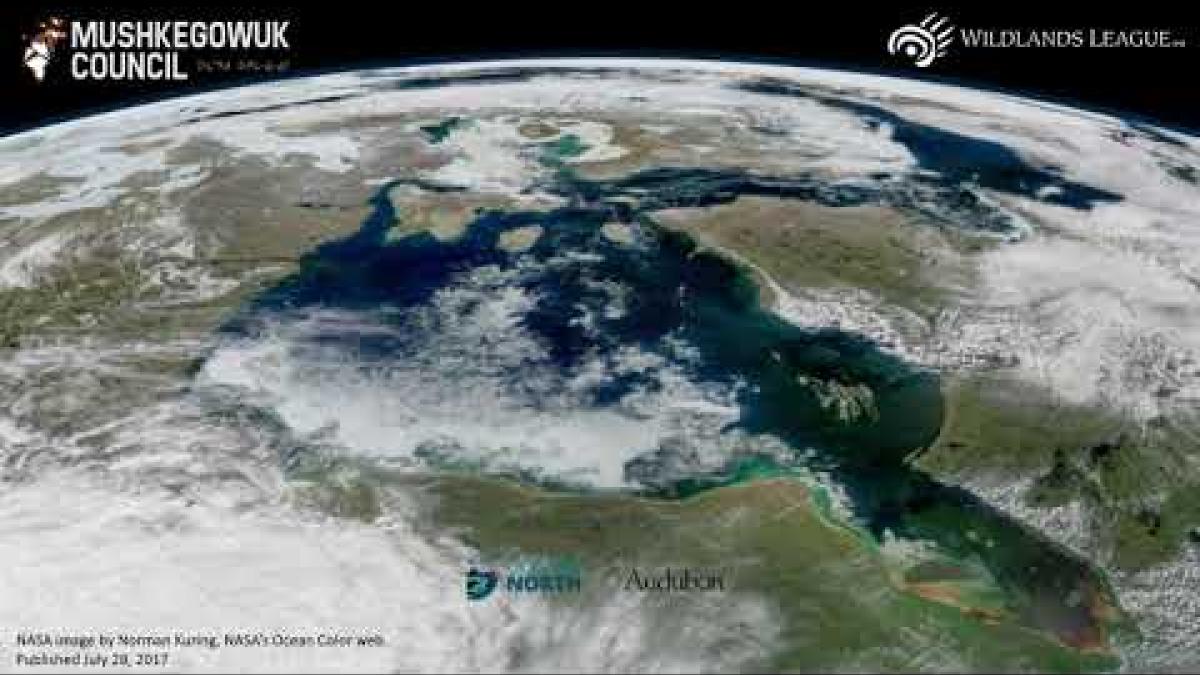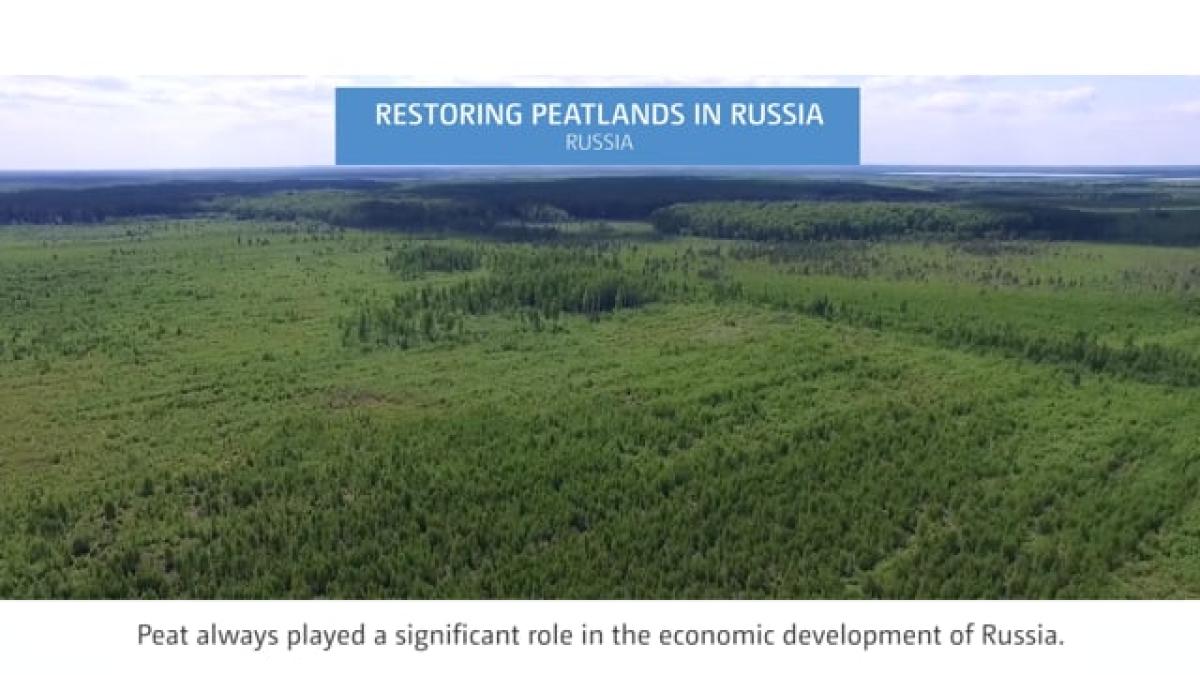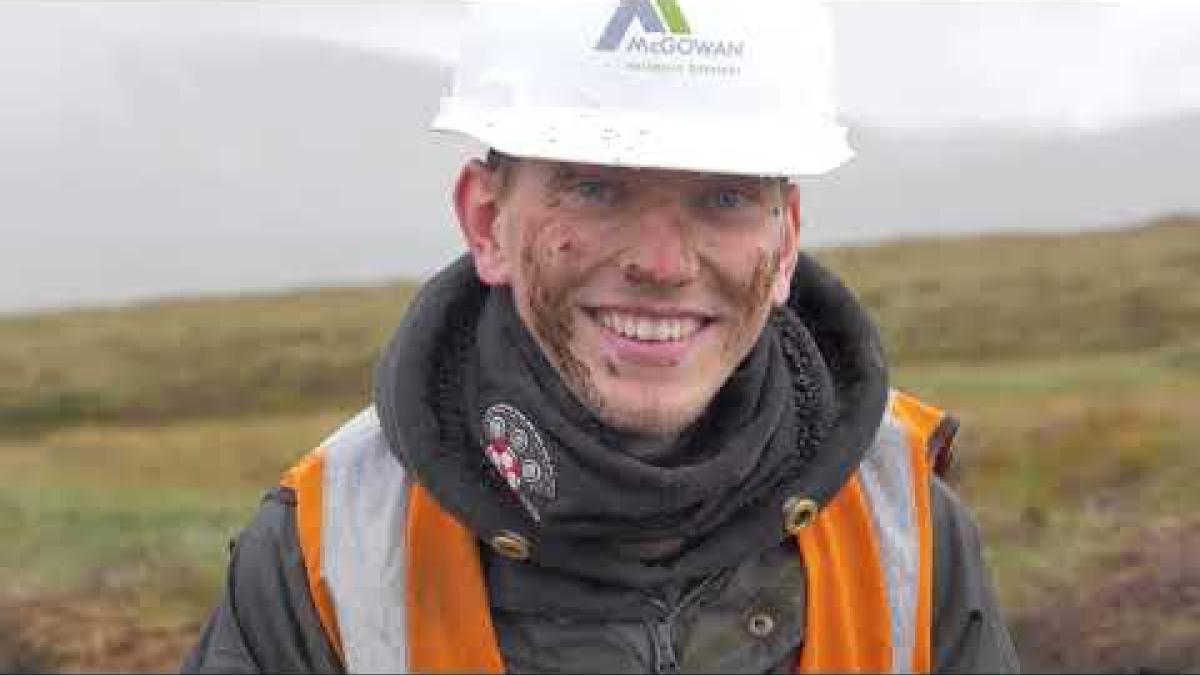
Early morning mist rising from the canopy of the lowland forest in the Danum Valley, Sabah, Borneo.
Credit: Nick Garbutt / Nature Picture LibraryPeatlands
Protect and restore threatened peatlands, one of the most ecologically diverse and carbon-rich ecosystems on the planet.
Although peatlands comprise only 3 percent of the earth’s land, they make up half of the world’s wetlands and store twice as much carbon as forests. Peatlands occur on every continent, including Antarctica, and people have gathered food, timber, and medicine from them for centuries. They provide essential flood protection and water filtration services for communities. However, they are under severe pressure from industrial activities and the effects of climate change. Many peatlands have been drained for agriculture and development, and others are drying out due to prolonged drought and rising temperatures, causing out-of-control fires. They could release large amounts of greenhouse gases as they further deteriorate and burn, changing from a carbon sink to a carbon source. Peatlands need to be protected, restored, and sustainably managed on a high-priority basis, especially in the tropics.
Action Items
Individuals
Learn why peatlands are critically important and what threatens them. Peat is partially decayed vegetation found in a water-soaked and oxygen-deprived environment. Types of peatlands include mires, fens, bogs, pocosins, muskeg, moors, and peat swamp forests. Peat can be as much as sixty feet thick and preserve up to 3,000 metric tons of carbon per hectare, making them an important carbon sink. Peatlands are refuges for rare and endangered plants and animals, such as sundews, bonobos, flying foxes, and orangutans. Indigenous people use peatlands for fishing, hunting, fiber, fruit, timber, and medicine. Indigenous knowledge and care are essential to the protection of peatlands from boreal regions to the tropics (see Wetlands Nexus and Mangroves Nexus).
- Threats to peatlands include draining for agriculture, especially for palm oil; extracting peat for horticulture or fuel; and oil drilling or mining. Current levels of deforestation, agricultural conversion, and burning could eliminate peatlands from Southeast Asia by 2030 (see Palm Oil Nexus).
- The oldest tropical peatlands have been storing carbon for as long as 47,000 years. In Europe, draining peatlands began in Roman times. In the tropics, humans began to transform peatlands two hundred years ago.
- Peatlands remain so little understood that the largest peatland in the tropics, the Cuvette Central of the Congo, was only discovered in 2017. We are still discovering the wildlife species they contain.
- When peat dries out, microbial activity increases in the carbon-rich soil, resulting in a sharp increase in greenhouse gas emissions.
- Degraded peatlands that have been converted to palm oil plantations are a large source of greenhouse gas emissions.
- Indonesia leads the world in peatland emissions due to peatland drainage and fires. Russia, China, and the United States are also large emitters.
- Of particular concern are permafrost peatlands, which could release large amounts of greenhouse gases if allowed to thaw under climate change.
- Drained peat catches fire easily. Peat fires can travel underground and last for months or years. Smoke from peatland fires in Russia in 2010 caused thousands of premature deaths, while Indonesian peatland fires in 2015 released more greenhouse gases per day than the entire U.S. economy and blanketed multiple countries with toxic smoke.
- It takes one or two decades for restored peatlands to start forming peat again and become carbon sinks.
Get to know your peatlands and speak out for them. Although they often have historical and cultural significance along with unique biodiversity, peatlands are often underappreciated.
- Take a virtual journey to peatlands around the world here.
- Find a peatland near you using the Global Peatland Database.
- Experience peatlands at Living Bog Project sites in Ireland; The Flow Country in Scotland; national parks such as Kouchibouguac or Wapusk in Canada; the Great Dismal Swamp and the Everglades in the U.S.
- Help research peatlands through citizen science. The UK has a map of active citizen science and community engagement projects. In Canada, Indigenous communities are partnering with researchers to assess carbon in Mushkegowuk territory.
- Advocate for peatlands and other wetlands. This op-ed invites using agroecology in the warming North to preserve Indigenous lifeways and protect peatlands. This one advocates for wetland protection at the state level in Vermont as a way to fight climate change.
- Join a social media site for peatlands, including the International Peatland Society’s Facebook and Instagram sites; the Facebook page for #peatlands; the Facebook page for People for Peat; and the Facebook page for Peatlands in Southeast Asia (see Key Players below).
Make consumption choices that preserve peatland. Palm oil plantations on peat are responsible for 1.5 percent of global CO2 emissions. The plantations also damage the Sumatran elephant and orangutan habitat. Horticultural peat harvesting, largely in Canada, also causes substantial emissions.
- Avoid palm oil products. The International Palm Oil Free Trademark and the Orangutan Alliance list products without palm oil. See Palm Oil Nexus for more ideas.
- Consider products made using illipe nuts. Illipe nut comes from trees that grow in peatlands and is one of the most promising sustainable crops in Indonesian peatlands. Illipe butter can be used in chocolate and cosmetics. It can provide income for local and Indigenous communities that can keep peatlands intact instead of draining them. Forestwise sells fair trade illipe butter and Lush and Chagrin Valley Soap and Salve sell cosmetics using illipe butter.
- Avoid using peat in horticulture. Most horticultural peat comes from peatlands in Canada, and successful restoration of excavated sites takes years. Alternatives include composted bark, composted green waste, or your own compost (see Compost Nexus). Locally sourced material is preferable. Shredded wood from forest thinning may be an option. Here is an online guide from the Responsible Sourcing Scheme (UK).
Groups
Farmers, Ranchers, and Landholders
Protect intact peatlands on land you own or use. Draining peatlands for agriculture only works in the short term. The organic soil decomposes, releasing stored carbon into the air, and the soil compacts, resulting in technical and financial challenges.
- Maintain the hydrology of bogs and fens and put in a buffer strip of shrubs and grasses to prevent fertilizer contamination and reduce invasive weeds. Prairie strips or hedgerows can also provide habitat for birds and pollinators.
- Don’t overgraze peatlands. Peatlands are easily damaged by trampling and slow to recover. Water buffalo are especially suited to peat grazing.
- Don’t burn peatlands. The scientific evidence is clear—peatlands do not require burning to maintain their health.
Transition to alternative uses of peatlands. Draining peatlands for agriculture doesn’t work. Consider alternatives such as ponds, paludiculture, or agroforestry for income.
- Use blocked drainage channels for fire breaks or beje ponds, a traditional system of fishing in Indonesia in which fish swim into the ponds during wet seasons and are removed during dry seasons.
- Implement paludiculture, a promising technique of growing peat-adapted species in hydrologically restored peat. In Germany, farmed sphagnum moss substitutes for mined horticultural peat. In Belarus, reeds are harvested for fuel, preserving the peat on which they grow. In Indonesia, traditional crops such as sago, illipe nut, and jetulung are peatland natives that can provide livelihoods while maintaining flood protection. Gelam may be a peat-compatible source of pulpwood.
- Use agroforestry to provide a buffer for intact peatlands, especially on mineral soils near peat. Intercropping trees with seasonal crops may allow communities around degraded peatlands to improve their economic conditions while allowing restoration (see Agroforestry Nexus).
- Keep bees. In Indonesia, native bees or honeybees both produce honey from peatland flowers.
Local Governments, Nonprofits, and Communities
Involve local communities in restoration, monitoring, and maintaining peatlands. A survey of policy makers, nonprofits, and researchers involved in peatland restoration in Indonesia highlighted the need for local involvement. Another study highlighted community input as necessary for beneficial outcomes. Communities are critical to the three main phases of peatland restoration: rewet peatlands, restore vegetation, and revitalize local economies.
- In Indonesia, communities are involved from planning, to construction, to monitoring drainage ditch-blocking projects. Community fire monitoring can be very effective in preventing fires and catching peatland drainage problems early.
Rewet peatlands. Rewetting is necessary to restore vegetation, as this study in North America and this one in Norway demonstrate.
- Blocking drainage ditches is an effective approach to maintaining the water table that has been used around the world. Blockage techniques can be adapted to local conditions.
- Rewet entire hydrological units. A piecemeal approach will leak water from one area of the unit to another, preventing the necessary water rise.
- Raise the water table as high as possible. The lower the water level, the greater the risk of fire and the higher the emissions from peat.
Revegetate rehydrated peatlands.
- Stabilize bare peat to prevent erosion. In the UK, heather brash has been used as a mulch that also provides heather seeds and moss spores. More detail here.
- Maintain stable water levels to promote revegetation. In two Swedish degraded peatlands, revegetation occurred spontaneously but took longer in the area with higher fluctuation in water levels.
- Replant, if needed, with local species. In temperate or boreal peatlands, sphagnum moss will reestablish itself if there is a source, but it can also be propagated offsite and inoculated offsite. Once it is established, other species can recolonize. In tropical peatlands, planting a diversity of species provides ecosystem services such as animal habitat and shade.
- Reforest peatlands only if trees are part of the local ecology. In tropical peat swamps, native trees are appropriate for regenerating peatlands. They provide shade and maintain humidity and can provide a livelihood for local communities with species such as sago and jelutung. However, afforestation projects on treeless peatlands can damage biodiversity and water quality, disturbing the peat’s ability to sequester carbon long term. In boreal and temperate peatlands, trees may increase fire risk (see Afforestation Nexus).
Companies
Maintain a peat-responsible supply chain. Illegal drainage of peatlands for palm oil continues with the collusion of major companies such as Procter & Gamble and Mondelēz, while pulp-producing giants Asia Pacific Resources International (APRIL) and Asia Pulp & Paper have both been found clearing peatlands illegally. Local communities have protested; their traditional livelihoods are threatened by the plantations.
- Find alternatives to palm oil or use palm oil from a credible certifier. See Palm Oil Nexus.
- Ensure that pulpwood is sourced responsibly, without destroying peatlands. Pulp is used both for paper and textile fibers such as rayon (viscose). Pulpwood companies in Indonesia continue to plant trees in degraded peatlands despite pledges to stop, raising the risk of out-of-control fires. Canopy provides a directory of environmentally friendly paper products and textile fiber for companies seeking to reduce emissions.
- Use substitutes for mined peat. Farmed sphagnum moss can support paludiculture on peatlands that have previously been used for agriculture. Wood fiber, shredded bark, compost, or biochar are other possibilities (see Biochar Nexus).
Governance
Protect existing peatlands and enforce existing protections. Peatland protection is a priority under numerous international agreements. About 12 percent of global peatlands have flipped from carbon sinks to carbon sources, mainly in temperate and tropical areas. Supporting peatland conservation and rewetting is one of the most cost-effective and efficient methods to prevent and reduce greenhouse gas emissions.
- Inventory peatlands and estimate greenhouse gas storage and emissions. Both intact peatlands and those that are drained need to be mapped, including their extent, their depth, and their use. It is also important to quantify changes in emissions from changes in land use.
- Identify internationally important peatlands to conserve. For peatlands to be managed as hydrological units, an entire watershed may be of international importance due to its biodiversity, its importance to migratory birds, its cultural significance, and its ecological intactness.
- Manage peatlands as hydrological units, which requires protecting shallow peat as well as deep peat. In Indonesia, deep peat is protected, but drainage of shallow peat is still permitted for oil palm plantations. However, draining shallow peat may also lower the water level in deep peat and creates similar problems. Here is a guide on peatland management published by the International Peatland Society.
- Enforce existing law. Oil palm plantations continue to expand in Indonesia over the protests of Indigenous people, disregarding their land rights and breaking Indonesian law.
Align land use and agricultural policy with climate change goals. Policies that encourage the drainage of peatlands drive enormous emissions. Many countries do not have national peatland policies in place. Paludiculture practitioners universally report that agricultural policy hinders its adoption.
- End peat use for fuel to reduce its disproportionate emissions. Ireland has committed to stop using peat in its power plants, using a just transition for workers in the peat industry. Finland plans to halve its peat consumption by 2030, and its rewilding efforts are reducing pollution from mined bogs.
- Phase out payments to agriculture on drained soils and support paludiculture. European Common Agricultural Practices heavily support agriculture on drained peatlands. Supporting paludiculture on rewetted peatlands aligns incentives with the need to keep peatlands wet. There is a particular need for long-term policy to support farmers’ transitions.
- Make import/export policies favorable to paludiculture farmers. For instance, an export ban on illipe nuts in Indonesia that reduced profit to farmers without improving the domestic market should be lifted.
- Support smallholder farmers with training, policy, and finance. Transitioning to paludiculture requires new skills and machinery, and may need financial support for slow-maturing tree crops such as sago.
Cooperate with other governments to share knowledge and best practices.
- The Republic of Congo and Indonesia, both of which have enormous peat areas, have an agreement to develop sound management of peatlands. They also agreed to help each other with capacity building and exchanges of information.
- A cooperative effort between Germany and Russia showed that ecological rewetting was a cost-effective way to restore peatlands and reduce fire risk.
Key Players
Organizations
International Peatland Society (Canada) is an organization of individual, corporate, and institutional members dedicated to the responsible management and Wise Use of peatlands and peat.
Wetlands International (Netherlands) works to inspire and mobilize society to safeguard and restore wetlands for people and nature.
Greifswald Mire Centre (Germany) offers science-based solutions for social challenges and coordinates the "Global Peatland Database", the largest database of the distribution and status of peatlands worldwide.
People for Peat (Malaysia) is a coalition that represents the second component of the Sustainable Use of Peatland and Haze Mitigation in ASEAN (EU-SUPA) program.
International Tropical Peatlands Center (Asia, Congo, Peru) focuses on efforts to converse and sustainably manage peatlands.
Mushkegowuk Council (Canada) works towards sustainably developed and protected lands and waters.
Snowchange Cooperative (Finland) has developed into a major force in international climate and indigenous policy and research.
Bord na Móna (Ireland) develops climate solutions for a greener future with a focus on peatlands.
Jikalahari (Indonesia) works for fair management of Riau forests for current and future generations.
John Muir Trust (Scotland) is dedicated to the conservation, protection, and restoration of the UK's wild places, including peatlands.
IUCN UK Peatland Programme (UK) exists to promote peatland restoration in the UK and advocates the multiple benefits of peatlands through partnerships, strong science, sound policy, and effective practice.
Global Peatlands Initiative (Global) is an effort by leading experts to save peatlands as the world’s largest terrestrial organic carbon stock.
Wildlife Conservation Society (Canada) saves wildlife and wild places (including peatlands) in Canada through science, conservation action, and inspiring people to value nature.
Learn
Watch
Bogland by Seamus Heaney from Bruce Derby (1 min.)
Palm Oil Production, Peatland Loss and CO2 Emissions by Wetlands Int'l (4 mins.)
Restoring Peatland Forests in Indonesia (Bahassa Indonesia) by Wetlands Int'l (6 mins.)
Why Is This Spot in the Congo Attracting So Much Attention? by Mongabay (7 mins.)
Measuring Carbon in Peru's Tropical Peatlands by CIFOR (6 mins.)
Peatlands—Climate Regulation and Biodiversity by Naturstyrelsen (14 mins.)
Peatland Legacy (Saving Ireland’s Peatlands) EE17 EP4 by Earth Horizon (24 min.)
Read
"How Ireland Is Abandoning Its Dirty Fuel" by Nessa Tierney / BBC
"Ex-Logger Leads Firefighters Defending Indonesia's Peatlands" by Harry Jacques / Thomson Reuters Foundation
"For the Love of Peat: Our Best Defence Against a Changing Climate" by Edward Struzik / The Walrus
"Smouldering Past: How a Fire Event Turned Me into an Environmental Historian" by Katja Bruisch / NiCHE
"Why Saving World's Peatlands Can Help Stabilize the Climate" by Ed Struzik / Yale Environment 360
Tropical Peatlands in the Anthropocene: Lessons from the Past by Cole et al. / ScienceDirect
Mires and Peat is a peer-reviewed internet journal focusing specifically on mires, peatlands and peat.
Fen, Bog & Swamp: A Short History of Peatland Destruction and Its Role in the Climate Crisis by Annie Proulx / Simon & Schuster
"Canada’s Peatlands: Towards A National Assessment" by Julie Van Offelen / Global Peatlands Initiative
Listen
Exploring the Great Dismal Swamp by Virginia Water Radio (5 mins.)
Culture of the Congo Peatlands by Living On Earth (5 mins.)
Bogcast 1: Blanket Bog for Beginners by Yorkshire Peat Partnership (13 mins.)
Peat Fires, Like Those Raging in Siberia, Will Become More Common in Canada by CBC Radio (27 mins.)
Brian Jackson on Peat Alternatives by A Way to Garden with Margaret Roach (26 mins.)
For the Love of Peat by 99 Percent Invisible Podcast (40 mins.)
Restoration for Peat's Sake by Mongabay Podcast (48 mins.)
Share this page




